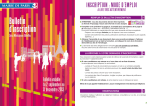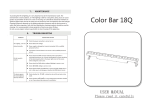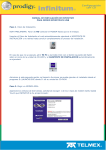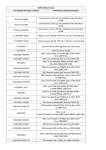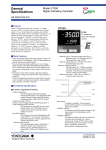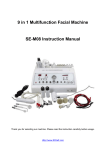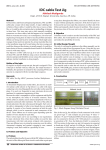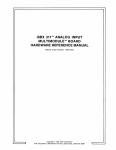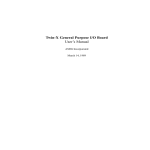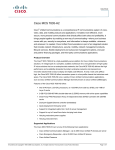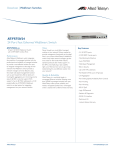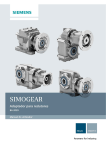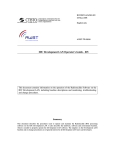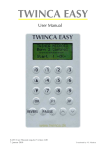Download A Control System for BEPC Storage Ring Injection Power Supplies
Transcript
A CONTROL SYSTEM FOR BEPC RING INJECTION POWER SUPPLIES H.Zhang, R.Zhang, S.Lu, IHEP, Beijing, China ABSTRACT A control system for controlling BEPC ring injection power supplies has been built. This control system is characterized by using Intel Bitbus network and manmachine graphic interactive interface. It is based on a Intel industrial PC with Intel iRMX for windows in it plus several Bitbus stations. The whole system has been examined completely and put into operation in May this year in place of the existing hardware control system. The new PC-Bitbus computer control system will be prepared to communicate with main VAX workstation through Ethernet and to be controlled directly by main computer X-window as soon as possible. 1 INTRODUCTION The existing BEPC ring injection supply control system was designed in 1985 and has run reliablly since 1987. It was a standalone hardware system due to the need for whole BEPC VAX-VCC-CAMAC computer control system. Main disturbing sources like Kickers were separated from the main system. From the development point of view, It’s time to substitute the hardware system by a computer system after such a long observation and operation experiences. We decided to use an Intel Bitbus network protocol and put controller stations as close to the supplies as possible in order to get better control quality. 2 SYSTEM APPLICATION The PC-BITBUS system is a complete autonomous computer control system, it controls over six injection supplies ---- four Kickers and two Lambersons. They are located along the ring injection spots for positron and electron injections respectively. The control system features in Bitbus, MS-Windows and Intel industrial PC 302i, which functions as a backbone of the distributed real time control system and acts as a development system for whole control system. fig. 1 system hardware architecture IRMX for windows of 32 bit real time, multitasking operating system installed in PC makes MS-Windows and MS-DOS as one of its tasks to run. But iRMX for Windows is a character-oriented system, MS-Windows has a good, powerful graphic functions with multiwindow and multitask. We should gain benifits from combining them for our control requirements. Our aim has been reached. No other specialized graphic control software are needed. Bitbus network adheres to IBM’s HDLC/SDLC protocol, comprises one primary station and eight secondary stations with two isolators, see Fig 1. Bitbus network operates at self-clocked, half-duplex mode, data transfer speed of 375 Kbps with two segments, maxmun distance of 300M per segment. iRMX for Windows communicates with Bitbus stations through the Bitbus driver developed by ourselves. Bitbus message frame is 20 bytes long, master station launchs the order command for Bitbus message transmission each time. A preconfigured compact real time multitasking executive iDCX51 has been preloaded on each Bitbus stations. MS-Windows DDE router and Library provided by iRMX for Windows facilitate it to set up a connection for message transfering to and from MS-Windows. The key issues for PC-BITBUS computer control system are how to communicate data between different working platforms. For examples, between MS-Windows and iRMX for Windows, between iRMX for windows and iDCX51 executive on stations. It is pleased that we solve these difficulties without seeking for dedicated software. see Fig. 2. slot of PC. Two shielded pairs come from PC to RCX 900 isolation modules for Bitbus network isolation and transient protection. Second level is 8 Bitbus secondary stations. They are grouped near the controlled supplies, each station installed one of Intel distributed control modules----iRCB 44/10A BITBUS Digit I/O Remote Controller Board or iRCB 44/20A BITBUS Analog I/O Remote Controller Board and/or MULTIMODULE iSBX 350, They are fixed on HRCX 910/920 Digital/Analog Signal Conditioning and Termination modules. The third level is supply interface like DAC units which are put into controlled supplies, in this case analog reference cables are less than one meter to assure control stability. There is a high performance 12 Mhz 8044 controller on each Intel distributed control board, up to 64 KB ROM and RAM with jumpers selection are easily accomodated on the board. We developed HRCX-910. HRCX-910 has 48 digit I/O used for iRCB 44/10A and iSBX-350. 13 bits of port A and port C of iRCB44/10A are output to DAC units through optical isolators TIL-117, 12bits as digital code, one bit as clock. Port B picks up status inputs from supplies. Three ports on Digital MULTIMODULE iSBX-350 run all in mode 0, on-off control routes to its port B through relay contacts. HRCX-910, iRCB44/10A and/or iSBX-350 those are installed on a U-type 19 inchs wide shelf form a BITBUS station. HRCX-920 is used for analog termination for iRCB 44/20A. Only 4 analog channels are in use, others of 16 channels are grounded, 2 DAC outputs are used for selftest. Analog isolation devices are BB 3652GJ which have good isolation electricity capability, better linearity, low temprature coefficient, high input impedence, and 5ma output load capability, gain are set to one, input range is within 0 - 10V with overvoltage protection. BB 722 isolation power source devices are worked with BB 3652 in order to get better performance. Each analog input is truely differenciated. HRCX-920 and iRCB44/20A construct one Bitbus station like HRCX-910. 4 SYSTEM APPLICATION SOFTWARE ARCHITECTURE fig. 2 system application software architecture 3 SYSTEM HARDWARE ARCHITECTURE System hardware architecture comprises three parts, see Fig. 1. Intel PC----80386 25DX AT Bus----is the heart of the whole system, placed at the central control room. IPCX 344 as Bitbus master station is plugged in a The whole application software may be devided into three levels. Top level is some procedures for control screen. Middle one is the heart of the whole application software, it consists of one main program and one small database with index programs in addition to two communication packages. Bottom level has a lot of I/O operations dedicated for defferent Bitbus station needs. see fig. 2. Graphic man-machine interface are finished through MS Visual Basic 3.0 in MS Windows 3.1. VB is a true object-oriented language, its universal powerful functions bring us one of farourite graphic programming tool. We program three pages, one for system control, two for help and other desplays. Control page is our main page. On it, there are on-off buttons which can be clicked to turn on-off supplies, supplie status desplay which can turn green or red like indicators, readback analog values which desplay truely like multi-digital meters, reference analog value setting inputs which employ several methods like pull-down menus for trim step selection, keyboard for directly setting value input, scroll bars for reference trimming. Pressing standardized button on the screen can have the supply standardized one time from present value to maximum, then back to zero, finally loop to original value. The whole computer screen is devided into two identical parts used for positron and electron injection controls respectively. DDE link implements MS-Windows message passing to and from iRMX for Windows. Two sides have masterslave relationship, client on iRMX for Windows side, server on MS-Windows side. The link is established from client request. Since control parameters change from time to time at administration of operators, hot links have to be created for on-off control, analog reference setting in order to receive changes in control parameters at any time. As with status signals and analog requisation values , they would be poked to server at every five second or so. Main programs in iRMX for Windows are written in C, they play a very important role in the whole control system. There is a database for all controlled signals in it. As matter of fact, database is a common data access area for data exchange and search. The database has four types of data, we usually search data in it using signal id or data type. Database refreshes every five second or so under normal condition. Bitbus driver is also a important one for PCBITBUS control system. Communication package has been finished under iRMX for Windows with C language. IPCX-344 is actually a gateway. The two byte registers (FIFOs) on it provide the path for bytes to move through the parallel interface. Bytes are read or written from the registers destinated: FIFO Data Byte and FIFO Command Byte to carry out data transfer between IBM PC bus (80386 CPU) and Bitbus (8044 Controller). Another important task for communication package is access to RAC task which as part of task 0 provides the means of invoking iDCX-51 Executive System Services from tasks on PC extension. PLM51, ASM 51and others are development tools for task code run on each BITBUS station with different functions. 5 QUESTIONS AND SOLUSIONS New PC-BITBUS computer control system has commissioned.. We met a big challeage during having the system examined at the field site, but easy expansion and flexible configuration for Bitbus distributed control system bring us a lot of benifits. Defferent supplies require different control mode took us a lot of time to find solusions. We have to move the control task code from stations to iRMX for Windows platform because of no in-circuit iCE-5100/044 emulator, no iUP-200A/201A programmer and no fast enough EEPROM. ISBX-350 MULTIMODULE board on BITBUS I/O Remote Controller Board seemed not to work correctly, iSBX-350 were replaced with iRCB 44/10A. 6 IN THE FUTURE PC-BITBUS distributed control system will be supervised by existing X-Window on VAX stationCAMAC system main console from Ethernet complying with TCP/IP protocol in the next a few months. Network communication application using Berkeley sockets will be prepared on MS-Windows 3.1 through VB or on iRMX for Windows through C. REFERENCES [1] IRMX for Windows data books, published by Intel Corporation, 1991,1992. [2] ‘Distributed Control module databook’, published by Intel Corporation, 1988. [3] ‘BITBUS interface handlers user’s manual’, published by Intel Corporation, 1987.



